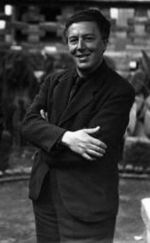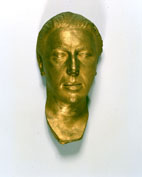André Breton
| André Breton | |
|---|---|
 André Breton in Mexico |
|
| Born | February 19, 1896 Tinchebray, Orne, France |
| Died | September 28, 1966 |
| Occupation | Writer |
| Nationality | French |
| Period | 20th century |
| Genres | Histories, poetry, essays |
| Literary movement | Surrealism |
| Notable work(s) | Surrealist Manifesto |
| Spouse(s) | Simone Kahn, Jacqueline Lamba, Elisa Claro |
| Children | Aube Breton |
André Breton (French pronunciation: [ɑ̃dʀe bʀəˈtɔ̃]) (February 19, 1896 – September 28, 1966) was a French writer, poet, and surrealist theorist, and is best known as the principal founder of Surrealism. His writings include the Surrealist Manifesto of 1924, in which he defined surrealism as "pure psychic automatism".
| Surrealism |
|
Surrealist music |
Contents |
Biography
Born to a family of modest means in Tinchebray (Orne) in Normandy, he studied medicine and psychiatry. During World War I he worked in a neurological ward in Nantes, where he met the devotee of Alfred Jarry, Jacques Vaché, whose anti-social attitude and disdain for established artistic tradition influenced Breton considerably. Vaché committed suicide at age 24 and his war-time letters to Breton and others were published in a volume entitled Lettres de guerre (1919), for which Breton wrote four introductory essays.
Breton married his first wife, Simone Kahn, on September 15, 1921. The couple moved to 42 rue Fontaine in Paris on January 1, 1922. The apartment at 42 rue Fontaine became home to Breton's collection of over 5,300 items: modern paintings, drawings, sculptures, photographs, books, art catalogs, journals, manuscripts, and works of popular and Oceanic art.
From Dada to Surrealism
In 1919 Breton founded the review Littérature with Louis Aragon and Philippe Soupault. He also associated with Dadaist Tristan Tzara. In 1924 he was instrumental to the founding of the Bureau of Surrealist Research.
In The Magnetic Fields (Les Champs Magnétiques), a collaboration with Soupault, he put the principle of automatic writing into practice. He published the Surrealist Manifesto during 1924, and was editor of La Révolution surréaliste from 1924. A group coalesced around him — Philippe Soupault, Louis Aragon, Paul Éluard, René Crevel, Michel Leiris, Benjamin Péret, Antonin Artaud, and Robert Desnos.
Anxious to combine the themes of personal transformation found in the works of Arthur Rimbaud with the politics of Karl Marx, Breton joined the French Communist Party in 1927, from which he was expelled in 1933. During this time, he survived mostly off the sale of paintings from his art gallery.
Under Breton's direction, Surrealism became a European movement that influenced all domains of art, and called into question the origin of human understanding and human perceptions of things and events.
During 1935, there was a conflict between Breton and Ilya Ehrenburg during the first "International Congress of Writers for the Defense of Culture" which opened in Paris in June. Breton, had been insulted by Ehrenburg—along with all fellow surrealists—in a pamphlet which said, among other things, that surrealists were "pederasts". Breton slapped Ehrenburg several times on the street, which led to surrealists being expelled from the Congress. Crevel, who according to Salvador Dalí, was "the only serious communist among surrealists" [1] was isolated from Breton and other surrealists, who were unhappy with Crevel because of his homosexuality and upset with communists as a whole.
In 1938 Breton accepted a cultural commission from the French government to travel to Mexico. After a conference held at the National Autonomous University of Mexico about surrealism, Breton stated after getting lost in Mexico City (as no one was waiting for him at the airport) "I don't know why I came here. Mexico is the most surrealist country in the world".
However, visiting Mexico provided the opportunity to meet Leon Trotsky. Breton and other surrealists sought refuge via a long boat ride from Patzcuaro to the town of Erongaricuaro. Diego Rivera and Frida Kahlo were among the visitors to the hidden community of intellectuals and artists. Together, Breton and Trotsky wrote a manifesto Pour un art révolutionnaire indépendent (published under the names of Breton and Diego Rivera) calling for a "complete freedom of art", which was becoming increasingly difficult in the world situation of the time.

In 1939 Breton collaborated with artist Wifredo Lam on the publication of Breton's poem "Fata Morgana", which was illustrated by Lam.
1940s
Breton was again in the medical corps of the French Army at the start of World War II. The Vichy government banned his writings as "the very negation of the national revolution"[2] and Breton escaped, with the help of the American Varian Fry and Harry Bingham, to the United States and the Caribbean in 1941. Breton learned to know Martinican writer Aimé Césaire, and later penned the introduction to the 1947 edition of Césaire's Cahier d'un retour au pays natal. During his exile in New York City he met Elisa, the Chilean woman who would become his third wife.
In 1944, he and Elisa traveled to the Gaspé Peninsula in Québec, Canada, where he wrote Arcane 17, a book which expresses his fears of World War II, describes the marvels of the Rocher Percé and the northeastern end of North America, and celebrates his newly found love with Elisa.
Later life
Breton returned to Paris in 1946, where he opposed French colonialism (for example as a signatory of the Manifesto of the 121 against the Algerian war) and continued, until his death, to foster a second group of surrealists in the form of expositions or reviews (La Brèche, 1961–1965). In 1959, André Breton organized an exhibit in Paris.
André Breton died in 1966 at 70 and was buried in the Cimetière des Batignolles in Paris.
Auction of Collection at 42 rue Fontaine
The apartment at 42 rue Fontaine was home to Breton's collection of over 5,300 items: modern paintings, drawings, sculptures, photographs, books, art catalogs, journals, manuscripts, and works of popular and Oceanic art.[3] Following Breton's death on September 28, 1966, Breton's third wife, Elisa, and his daughter, Aube, allowed students and researchers access to Breton's archive and collection. After thirty-six years, when attempts to establish a surrealist foundation to protect the collection were met with resistance, the collection was auctioned by CalmelsCohen at Drouot-Richelieu.[4] A wall of the apartment is preserved at the Centre Georges Pompidou.[5][6]
Collection
- Selected Modern Painters: Pierre Alechinsky, Aloïse Corbaz, Braulio Arenas, Arman, Jean Arp, Enrico Baj, Ben, A Benquet, Alexandre Boileau, Bona Pieyre de Mandiargue, Michline Bounoure, André Bourdil, Francis Bouvet, Victor Brauner, Elisa Breton, Jorge Caceres, Jacques Callot, Jorge Camacho, Paul Colinet, Pierre Courthion, Fleury-Joseph Crépin, Salvador Dali, André Demonchy, Ferdinand Desnos, Deyema, Oscar Dominguez, Enrico Donati, Mirabelle Dors, Marcel Duchamp, Baudet Dulary, René Duvilliers, Yves Elléouët, Nusch Eluard, Paul Eluard, Colette Enard, Jimmy Ernst, Max Ernst, Henri Espinoza, Fahr el Nissa Zeid, Jean Fautrier, Luis Fernandez, Charles Filiger, Alexandre Evariste, Johann Henrich Füssli, Paul Gauguin, Alberto Gironella, Arshile Gorky, Eugenio Granell, Henri de Groux, René Magritte, Joan Miro, Pablo Picasso, Man Ray, Diego Rivera, Yves Tanguy, Adolf Wölfli, etc.
- Selected Photographers: Manuel Alvarez Bravo, Pierre Argillet, Bach Fritz, Jacques-André Boiffard, Brassaï, Elisa Breton, Claude Cohen, Henri Cartier-Bresson, Léo Dohmen, Paul Dacceti, Izis, Dora Maar, Man Ray, Raoul Ubac, Emile van Moerkerken, etc.
- kachina dolls
Marriages
Breton married three times:
- His first wife, from 1921 to 1931, was Simone Collinet, the former Simone Kahn (1897–1980).
- His second wife was the former Jacqueline Lamba, with whom he had his only child, a daughter named Aube.
- His third wife was the former Elisa Claro.
Works
His works include the case studies Nadja (1928) and Mad Love (L'Amour fou) (1937).
Selected works:
- Mont de piété, 1919
- S'il Vous Plaît, 1920 - If You Please
- Les Champs magnétiques, 1920 – The Magnetic Fields
- Manifeste du surréalisme, 1924 – The Surrealist Manifesto
- Les Pas Perdus, 1924 – The Lost Steps
- Poisson soluble, 1924 – Soluble Fish
- Un Cadavre, 1924 – A Corpse
- Légitime Défense, 1926 – Legitimate Defense
- Le Surréalisme et la peinture, 1926 – Surrealism and Painting
- Nadja, 1928 – Nadja
- L'Immaculée Conception, 1930 – The Immaculate Conception
- Deuxième Manifeste du surréalisme, 1930 – The Second Manifesto of Surrealism
- Ralentir travaux, 1930 – Slow Down Works
- La Revolver à cheveux blancs, 1932 – The Revolver Has White Hair
- Les Vases communicants, 1932 – The Communicating Vessels
- Le Message automatique; 1933 – The Automatic Message
- Qu'est-ce que le surréalisme, 1934 – What Is Surrealism
- L'Air de l'eau, 1934 – Looks Like Water
- Point du Jour, 1934 – Not of the Day
- Position politique du surréalisme, 1935 – The Political Position of Surrealism
- Notes sur la poésie, 1936 (with Paul Éluard) – Notes on Poetry
- L'Amour fou, 1937 – Mad Love
- Point du jour, 1937
- Dictionnaire abrégé du surréalisme, 1938 (with Paul Éluard) – Abridged Dictionary of Surrealism
- Manifesto for an Independent Revolutionary Art, 1938 (with Leon Trotsky)
- Fata Morgana, 1940
- Anthologie de l'humour noir, 1940 – Anthology of Black Humor
- Arcane 17, 1945 – Arcane 17
- Jeunes Cerisiers garantis contre les lièvres, 1946 – Young Cherry Trees Secured against Hares
- Ode à Charles Fourier, 1947 – Ode to Charles Fourier
- Yves Tanguy, 1947
- Poèmes 1919–48, 1948
- La Lampe dans l'horloge, 1948 – The Lamp in the Clock
- Martinique, charmeuse de serpents, 1948
- Entretiens, 1952 – Discussions
- La Clé des champs, 1953 – The Key of the Fields
- Farouche à quatre feuilles, 1954 (with Lise Deharme, Julien Gracq, Jean Tardieu) – Wild to Four Leaves
- Les Manifestes du surréalisme, 1955 – The Manifestoes of Surrealism
- L'Art magique, 1957 – The Magic Art
- Constellations, 1958
- Le la, 1961
- Selected Poems, 1969
- Perspective cavalière, 1970
- What is Surrealism? Selected Poems, 1978
- Poems of André Breton, 1982
Life beyond art
Breton was an avid collector of art, ethnographic material, and unusual trinkets. He was particularly interested in materials from the northwest coast of North America. When faced with a financial crisis in 1931, most of his collection (along with his friend Paul Éluard's) was auctioned off. He subsequently rebuilt the collection in his studio and home at 42 rue Fountaine, which was preserved by family members from the time of his death until 2003, at which time his books, art, and ethnographic materials were auctioned by Calmels Cohen. Nine previously unseen manuscripts, including the Manifeste du surréalisme, were auctioned by Sotheby’s in May 2008.[7]
See also
- Anti-art
- Hector Hyppolite
References
- ↑ Crevel, René. Le Clavecin de Diderot, Afterword. pp. 161.
- ↑ Franklin Rosemont André Breton and the First Principles of Surrealism, 1978,ISBN 0-904383-39-X.
- ↑ André Breton, 42, rue Fontaine : tableaux modernes, sculptures, estampes, tableaux anciens. Paris : CalmelsCohen, 2003.
- ↑ "Andre Breton's 42 rue Fontaine Art Collection goes to Auction." Afterimage, March-April, 2003. http://findarticles.com/p/articles/mi_m2479/is_5_30/ai_99309212/
- ↑ "Surrealist Art." Centre Pompidou - Art Culture Mus. Web. 11 Mar. 2010. <http://www.centrepompidou.fr/education/ressources/ENS-surrealistart-EN/ENS-surrealistart-EN.htm>.
- ↑ "Centre Pompidou - Mur De L'atelier D'Andr." Centre Pompidou - Art Culture Mus. Web. 22 Mar. 2010. <http://www.centrepompidou.fr/Pompidou/Musee.nsf/Docs/ID470F5FAF0BF671A5C12576EE002D7764?OpenDocument&salle=1N5S22=salle&Key=1N5&sessionM=3.2.1&L=1>.
- ↑ "Nine Manuscripts by André Breton at Sotheby's Paris". ArtDaily.org. 2008-05-20. http://www.artdaily.org/index.asp?int_sec=2&int_new=23096. Retrieved 2009-03-28.
- André Breton: Surrealism and Painting - edited and with an introduction by Mark Polizzotti.
- Manifestoes of Surrealism by André Breton, translated by Richard Seaver and Helen R. Lane. ISBN 0-472-06182-8